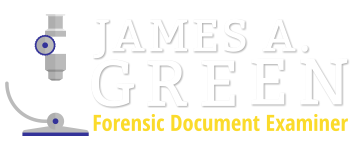As a Forensic Document Examiner, I provide a resource for resolving alleged forged document issues in civil and criminal cases. For clarification, the term ‘forgery’ is a legal term, used to broadly define the intentional falsification of a signature or document. It is normally the result of the intent by a person to deceive another for financial gain.
I believe two of the most common types of forgery cases are signature fabrications and document alterations. Document examiners are trained to analyze signatures and handwriting during their primary training. I also receive training at professional conferences attended each year. To determine if the questioned writing is genuine or not, it is compared with known specimens of the purported writer.
Common document examinations include signatures on wills, contracts, mortgage documents and checks. You may have a different writing issue such as a threatening note, a sexually harassing message, diary entries, etc. In my private practice, I receive more will and estate related document cases than any other type.
A variation of a common free-hand signature simulation, is a “cut and paste” fabrication. However, nothing is sacred in the world of cut and paste document deceptions. In addition to signatures, I have identified similar processes used for the transfer of notary signatures and seals as well as other official stamps.
Clients are also victimized by the alteration of documents in other ways. Think of data on contracts, journals, inventory lists, time sheets, or medical records. Writing or numerals may be added, deleted or obliterated for a self-serving purpose.
A document examiner will use various laboratory instruments to resolve such issues. For example, a Video Spectral Comparator (VSC) is designed to examine inks in the infrared and ultra violet light spectrums.
If you have any of the document issues mentioned, please call to discuss your case.

